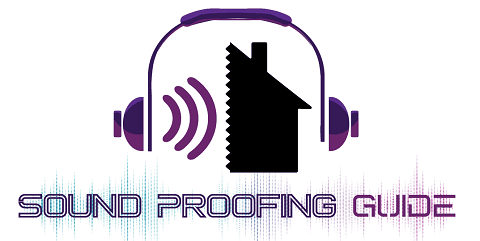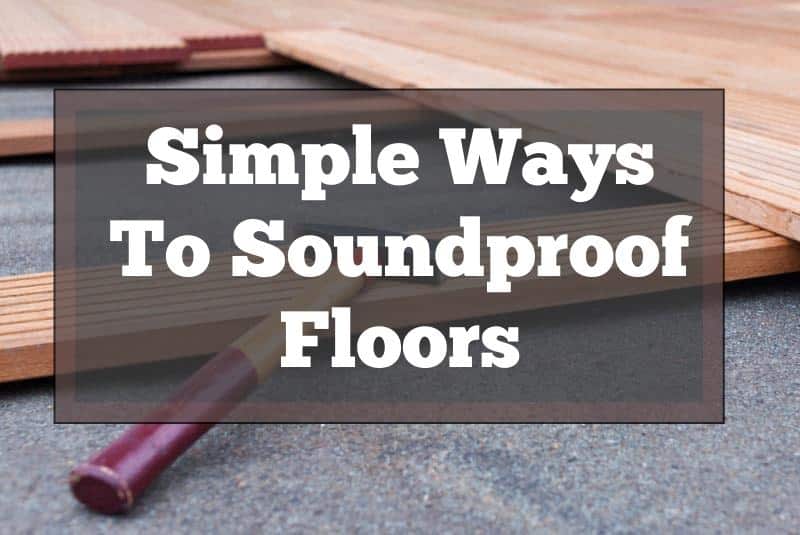In this article, I will be talking about how to soundproof an apartment floor in quick, easy steps that work. I will show you how to avoid all sounds from noisy people living downstairs or complaints about you being the noisy one upstairs.
Before shifting to my apartment, I used to live in a rented apartment just above my landlord. I prefer a quiet, peaceful place, so did my landlord. It was a perfect match. However, I have a terrible habit of listening to music loud to blow off my steam now and then, which pissed my downstairs neighbor a lot. And once, I started home workout things got out of hand, and my landlord asked me to evacuate or stop making all those noises.
I had no other option but to opt for soundproofing my apartment floor as stopping many of the noises about which my landlord was complaining was not possible without it.
I wasn’t going to spend a lot on it as was not planning to stay long, so professional help was not an option. So, I decided to look at methods on the internet for soundproof floor and do it myself. Although I wasn’t expecting a complete noise reduction without professional help, the results left me completely amazed.
Soundproofing my apartment floor made not only my life but also my downstairs neighbors life so much quieter and peaceful. In this article, I will share what all solutions worked for me and what mistakes I made, which you can avoid in your DIY project.
Page Contents
Soundproofing a Floor: The Basics
When you are soundproofing any part of your apartment, you need to know exactly what type of sound we are looking to address. There are mainly two kinds of noises for which we need floor soundproofing.
Airborne noise
Sounds that are transmitted through the air without any physical contact with your walls. The barking of a dog, sounds of a train passing through, lawn mowing in the neighborhood, or music from your neighbor’s place, these can be considered noises carried through the air. These sounds are easier to insulate as gaps have to be sealed to stop such noise.
On-impact noise/Structure borne noise
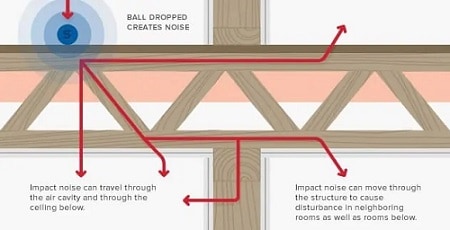
These are the noises that are created on a direct impact with a body, like an object colliding with your wall, or walking on the floor whose sound is carried through the ceiling or the floor of the people living below your apartment. These noises are a little bit difficult to insulate than airborne noises.
So, how can you soundproof your floor? Well, I will be talking about ways and methods of soundproofing floors in detail that can help reduce both of these types of noises in your home.
Cheap Ways to Soundproof the Apartment Floor
1. Lay Carpets with Carpet Padding on the Floor
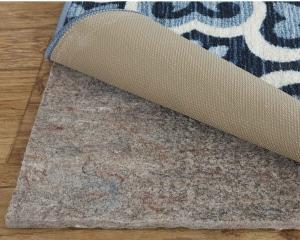 Laying carpet padding underneath traditional carpets is a great way to soundproof the floors from on- impact and airborne noises. This is the most obvious and cheapest way to go when you want to soundproof your floor.
Laying carpet padding underneath traditional carpets is a great way to soundproof the floors from on- impact and airborne noises. This is the most obvious and cheapest way to go when you want to soundproof your floor.
Carpet pads have to be glued down to the floor or can also be installed using tack strips to prevent shifting. Try covering as much as area as possible with carpeting for better results.
Make sure to buy a tightly woven material rather than loosely woven as thicker and denser materials work best in floor sound insulation.
I am currently using Mohawk Latex Non-Slip Rug Pad, and I am highly satisfied with them.
2. Interlocking Floor Mats
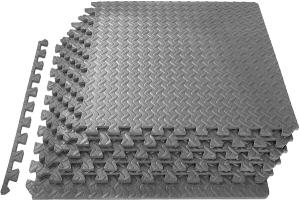 Interlocking floor mats look just like a large jigsaw puzzle. Using these mats is one of the simplest ways of floor soundproofing. All you have to do is cover the entire floor by connecting the mats as if one large jigsaw puzzle.
Interlocking floor mats look just like a large jigsaw puzzle. Using these mats is one of the simplest ways of floor soundproofing. All you have to do is cover the entire floor by connecting the mats as if one large jigsaw puzzle.
These floor mats are made of high-quality foam or rubber and are available in various designs and colors. I am currently using Prosource Puzzle Exercise Mat for my gym room, and I am satisfied with its results.
Interlocking floor mats are durable, water-resistant, easy to clean, and also shock- absorbing. They are also ideal for use in the garage, gym rooms, and studios.
The only downside to these floor mats is that they are not effective dampening all the noises if used alone, make sure to use them with the combination of other soundproofing products for achieving the best results.
3. Acoustic Floor Underlayment
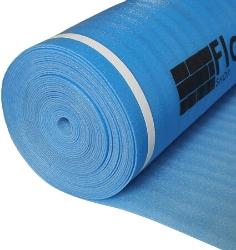 Acoustic floor underlayment is installed above the bare hardwood or vinyl floor. It is usually used with a combination of other products like interlocking floor mats or carpets to provide an extra sound-absorbing barrier.
Acoustic floor underlayment is installed above the bare hardwood or vinyl floor. It is usually used with a combination of other products like interlocking floor mats or carpets to provide an extra sound-absorbing barrier.
Floor mats or carpet padding are installed over acoustic floor underlayment, which creates an effective barrier and provides extra insulation on vinyl floors or bare hardwood. However, please make sure you do not breach any contract or lease term with your homeowner.
Most of these underlayments will come in rolls and are easy to install. Unroll the material on the floor, making sure that it covers each edge and corner of the floor and then secure it to the floor using nails or adhesive.
4. Install Mass Loaded Vinyl (MLV)
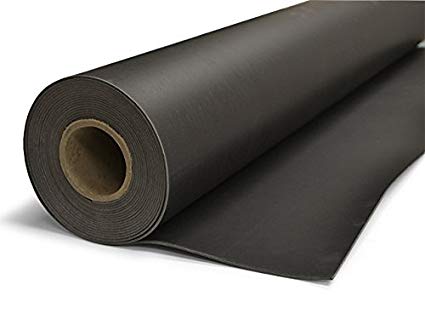 Mass Loaded Vinyl is a high- mass, high- density material that acts as an acoustic sound barrier wherever it is installed. It can be installed on floors, ceilings, doors, or along the walls of an apartment.
Mass Loaded Vinyl is a high- mass, high- density material that acts as an acoustic sound barrier wherever it is installed. It can be installed on floors, ceilings, doors, or along the walls of an apartment.
As we know, mass and density are some of the critical components when it comes to soundproofing materials. And since MLV has both the mass and the thickness, they turn out to be excellent soundproofing materials that can be used to soundproof your floor.
They are installed on floors similar to acoustic floor underlayment, unroll across the flooring, and then use nails to attach MLV to your floor. TMS Mass Loaded Vinyl has given be the best results in terms of noise cancelation, durability, and quality.
5. Green Glue Compound
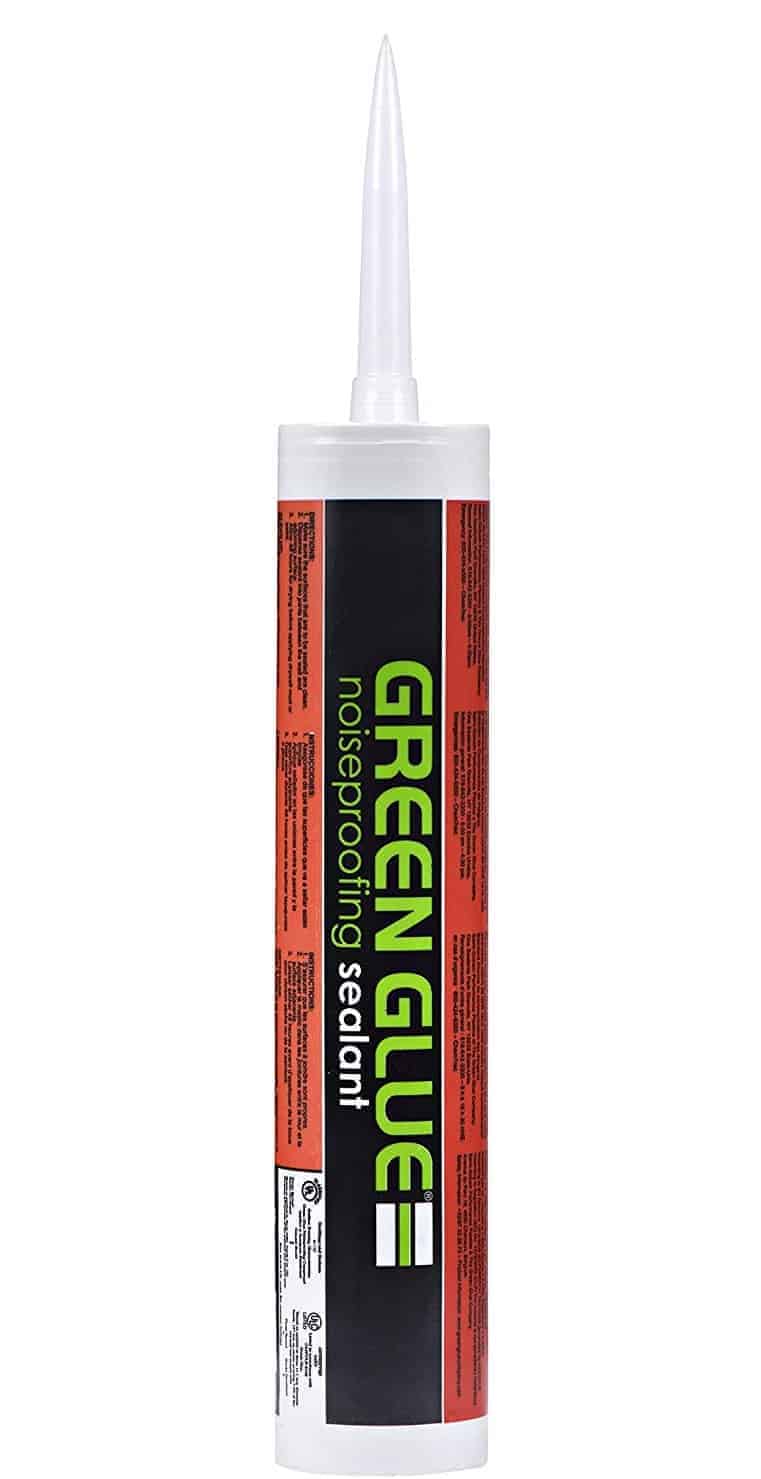 You might be wondering how some glue can impact soundproofing, reduce noise, etc. Well, the green glue compound consists of a polymeric formula that helps in sound deadening when applied between two soundproofing materials. This can be used to secure two loose materials safely without using nails or screws.
You might be wondering how some glue can impact soundproofing, reduce noise, etc. Well, the green glue compound consists of a polymeric formula that helps in sound deadening when applied between two soundproofing materials. This can be used to secure two loose materials safely without using nails or screws.
Using nails and screws can be damaging to the floors of your apartment, and due to their presence, there is a chance that sound will vibrate through them, making your whole soundproofing project a fail.
So using the Green Glue adhesive to attach two soundproofing materials is not only useful for making sure that your floors remain damage-free but is also suitable for providing more sound insulation.
This compound converts sound energy into heat energy. When a sound wave hits the material, the polymeric material converts the vibration of the air molecules into heat energy, thus dampening the sound.
This compound can be used on MDF, Plywood, Cement board, or OSB.
Soundproofing Solutions For Different Apartment Floor
How to soundproof a new construction floor? – When you are constructing/renovating your apartment floor, it’s the best time to soundproof your floor as it’s easy to addresses all the gaps.
Have a look at the various flooring options and the considerations you should take into account for having a permanent soundproof floor.
Hardwood and Laminate Floors
Hardwood is a problematic material to soundproof because they are hard, and they amplify the on-impact sounds because they do not absorb sound at all. Even airborne sounds can become significant when it comes to hardwood flooring.
To soundproof hardwood floor, it is best to use impact barrier underlayment to help dampen on- impact noise. Underlayment will create a cushion between the subfloor and the hardwood floor, which makes sure to decrease the pressure when force is applied and reduces the sound produced.
Underlayment also resists moisture and mold. You can also install some other soundproofing material over the underlayment to make sure that all types of sound, including the airborne noise, are deadened. Sticking them to the underlayment will minimize the damage on the floor installed just above it.
Now when installing the hardwood above the underlayment, make sure to glue it down instead of using nails or screws to secure them because nails or screws can carry the sound energy through vibration and your soundproofing project will not be as much satisfying as you want it to be.
Similar soundproofing with underlayment should be done to laminate flooring because they also amplify on- impact and airborne noises.
Ceramic Tile Floors
While dealing with tiles and stones, you have to be careful that they do not crack because they are way more prone to damage than other types of floors. Ceramic tile floors can also be soundproofed using underlayment. The trick is in the nature of underlayment used to soundproof the ceramic floor.
Underlayment, which is designed to be placed under a mortar, should be used while working with tiles and stones. This underlayment will help deaden and dampen the sound and will also prevent the tiles from cracking after installation, which is a very crucial thing to consider for soundproofing tile floors.
Soundproofing a Concrete Floor
Concrete floors are dense and carry a lot of mass, which makes them excellent for sound insulation, especially against airborne sounds. But still when it comes to on- impact noises, there is still a chance that you will be able to hear the noise.
Adding an absorbent layer over the concrete floor will be an excellent idea to deaden the on- impact sound. A simple combination of underlayment and carpet will also work. Acoustic underlay and carpet combination will be enough for you to make your concrete floor completely soundproofed against all types of sounds.
Soundproofing a Timber Floor
Timber floors have cavities under them through which sounds will vibrate and will travel between the floors.
There are a few ways to soundproof a Timber Floor:
- Fit Acoustic insulation beneath the floorboards.
- Install a sprung floating floor.
- Install acoustic grade underlay.
Conclusion
You can achieve maximum floor noise proofing if you use all the above methods. So, lay down MLV, then the floor underlayment, then a thick carpet padding or interlocking floor mats, and your downstairs neighbors won’t hear a sound.
So finally, with these methods, you can go and start your soundproofing project knowing the ins and outs through all the technicalities of soundproofing. This project can be fun if you take the necessary precautions and keep essential things in mind.
And do not forget to ask for help from a friend if you think you will not be able to carry it alone because asking for help is way better than to complete the whole project unsuccessfully because of some technical issues. Have a peaceful time.
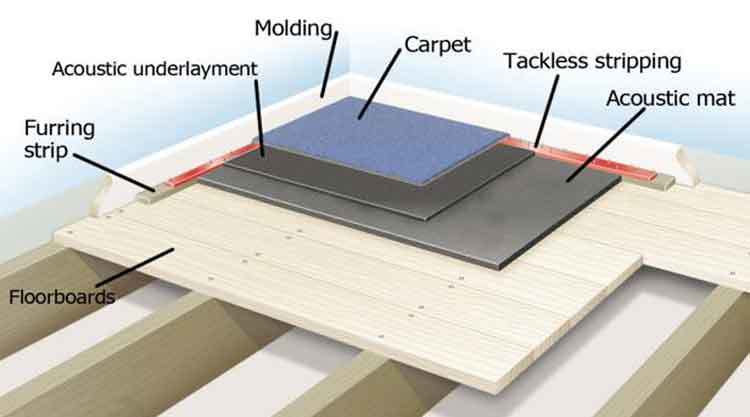
FAQ’s Related To Soundproofing Apartment Floor
What is the ideal method to soundproof the apartment floor?
I believe we all have an idea of why we start layering up our clothes in harsh winters. We want to trap the warm air in between those layers to keep us warm and cozy, right? Similarly, we can use all the methods above in layers to soundproof the floor.
The objective behind creating such layers is to trap the soundwaves within these layers leading them to bounce and get sucked up within the layers and eventually die down.
While a soundproofing layer can partially absorb the soundwaves, there is partial penetration through the layer as well. If there are one or two extra layers to absorb these partial penetrations, then the resultant noise becomes almost nil, giving us the most satisfactory quietening mechanism for our floors.
What household materials can be used for soundproofing the floor?
Since any thick or dense material is an efficient noise dampener, you can spread out thick tightly-woven rugs, old blankets, carpets, or rubber mats on the floor and watch them work magic in numbing unwanted noises to some extent.
